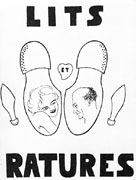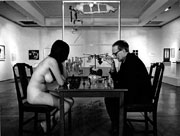|
| Click
to enlarge |

|
Marcel
Duchamp,
Note 224, from Paul Matisse, Marcel Ducahmp: Notes, 1980
© 2000 Succession Marcel Duchamp, ARS, N.Y./ADAGP, Paris. |
| Click
to enlarge |

|
| Francis Picabia, Cover of
Litterature, No. 7 (1 December, 1922) |
Marcel Duchamp's teammate
(1)
Francis Picabia illustrated Duchamp's lits-et-rature (2)
pun for the cover of Litterature No. 7, 1.12.1922. Two large
male shoes are pointing downward between two smaller upwardly pointing
female shoes. One sole has a picture of a woman; another sole the picture
of a man. Picabia trisected the name "Litterature" and wrote
above the shoes "LITS" ["beds"], in-between the shoes "ET"
["and"], and below "RATURES" ["erasures"]. (The relative position
of the shoes unambiguously indicates what bedroom activity the couple
is enjoying.) In a generation afreud of nothing (3)
this is a picture of sublimation: literature is a product of erasing
what we do in bed.
| Click
to enlarge |

|
Photograph
of Marcel Duchamp and Eve Babitz posing for the photographer Julian
Wasser during the Duchamp retrospective at the Pasadena Museum of
Art, 1963
© 2000 Succession Marcel Duchamp, ARS, N.Y./ADAGP, Paris.
|
Forty-one years later
Duchamp responded to his departed friend's gambit with this picture
of Duchamp and the nude Eve Babitz playing chess (4).
The goal of chess is to mate. We can thus see this picture as the record
of a tableau vivant of a word play (5).
Since Freud, vulgar theorists have held that chess and art, to pick
two examples, are sublimations of sex. Given Duchamp's attitude towards
wordplay versus theory, it is better to see his life long interest in
chess and eroticism as a sublimation of this picture's wordplay! Given
that the double meaning of "mate" does not exist in French, at last
we have a satisfactory explanation of why Duchamp had to emigrate to
America. In other words: in the beginning was the word; in the center
the pun (6).
 1. Cabanne asked Duchamp
"Who have your best friends been?" Duchamp replied, "Obviously Francis
Picabia, who was a teammate, so to speak." A few paragraphs later, speaking
of Litterature's editor, Andre Breton, Duchamp used chess as
a trope for engaged human interaction: "It's a somewhat difficult sort
of friendship, you see what I mean? We don't play chess together, you
understand?" Pierre Cabanne, Dialogues with Marcel Duchamp, trans.
Ron Padgett, Da Capo Press, Inc., 1979, p. 101. 1. Cabanne asked Duchamp
"Who have your best friends been?" Duchamp replied, "Obviously Francis
Picabia, who was a teammate, so to speak." A few paragraphs later, speaking
of Litterature's editor, Andre Breton, Duchamp used chess as
a trope for engaged human interaction: "It's a somewhat difficult sort
of friendship, you see what I mean? We don't play chess together, you
understand?" Pierre Cabanne, Dialogues with Marcel Duchamp, trans.
Ron Padgett, Da Capo Press, Inc., 1979, p. 101.
 2.
Stephen Jay Gould discusses this annihilating pun in "The Substantial
Ghost: Towards a General Exegesis of Duchamp's Artful Wordplays," Tout-fait:
The Marcel Duchamp Online Journal, Vol. 1, no. 2 (May 2000) [http://www.toutfait.com/issues/
issue_2/Articles/gould.html] Duchamp's pun appears as note 224
of Marcel Duchamp, Notes, Arrangement and Translation Paul Matisse,
G. K. Hall & Company, Boston, 1983. Arturo Schwarz lists the pun as
S 18 in his "Elements of a descriptive bibliography of Marcel Duchamp's
writings, lectures, translations and interviews," in The Almost Complete
Works of Marcel Duchamp, Arts Council of Great Britain, London,
1966; and as No. 25 in his bibliography of the same title in his The
Complete Works of Marcel Duchamp, third revised and expanded edition,
Vol. II, New York, 1997, p. 900. Schwarz mentions the pun and the cover
in Complete Works, Vol. I, p. 31. Robert Lebel mentions the puns
Duchamp published in Litterature in "Marcel Duchamp and Andre Breton,"
in Anne D'Harnoncourt and Kynaston McShine, ed., Marcel Duchamp,
The Museum of Modern Art, 1973, pp. 135-141. The Picabia cover is reproduced
in Dawn Ades, Dada and Surrealism Reviewed, Westerham Press,
1978, p. 175, and Marcel Duchamp: Work and Life, ed. Pontus Hulten,
MIT, 1993, p. 73. Ades lists among the contents of the issue: "Robert
Desnos, 'Rrose Selavy'. Puns by Desnos which he claimed were transmitted
by Rrose Selavy". Hulten discusses this issue of the journal under the
heading "1 December 1922". 2.
Stephen Jay Gould discusses this annihilating pun in "The Substantial
Ghost: Towards a General Exegesis of Duchamp's Artful Wordplays," Tout-fait:
The Marcel Duchamp Online Journal, Vol. 1, no. 2 (May 2000) [http://www.toutfait.com/issues/
issue_2/Articles/gould.html] Duchamp's pun appears as note 224
of Marcel Duchamp, Notes, Arrangement and Translation Paul Matisse,
G. K. Hall & Company, Boston, 1983. Arturo Schwarz lists the pun as
S 18 in his "Elements of a descriptive bibliography of Marcel Duchamp's
writings, lectures, translations and interviews," in The Almost Complete
Works of Marcel Duchamp, Arts Council of Great Britain, London,
1966; and as No. 25 in his bibliography of the same title in his The
Complete Works of Marcel Duchamp, third revised and expanded edition,
Vol. II, New York, 1997, p. 900. Schwarz mentions the pun and the cover
in Complete Works, Vol. I, p. 31. Robert Lebel mentions the puns
Duchamp published in Litterature in "Marcel Duchamp and Andre Breton,"
in Anne D'Harnoncourt and Kynaston McShine, ed., Marcel Duchamp,
The Museum of Modern Art, 1973, pp. 135-141. The Picabia cover is reproduced
in Dawn Ades, Dada and Surrealism Reviewed, Westerham Press,
1978, p. 175, and Marcel Duchamp: Work and Life, ed. Pontus Hulten,
MIT, 1993, p. 73. Ades lists among the contents of the issue: "Robert
Desnos, 'Rrose Selavy'. Puns by Desnos which he claimed were transmitted
by Rrose Selavy". Hulten discusses this issue of the journal under the
heading "1 December 1922".
 3. Attributed to the
American expatriate "Lost Generation" which occupied Paris in the 1920s. 3. Attributed to the
American expatriate "Lost Generation" which occupied Paris in the 1920s.
 4. Marcel Duchamp
and Eve Babitz playing chess during the Duchamp retrospective at the
Pasadena Museum of Art in 1963. The photograph by Julian Wasser is reprinted
in numerous places, including West Coast Duchamp, Bonnie Clearwater,
ed., Grassfield Press, Miami Beach, 1991, p. 75, fig. 34; additional
photographs of the scene, including a page of Wasser's contact sheets,
are on p. 73, fig. 33 and p. 75, fig. 35. Dickran Tashjian discusses
the circumstances of taking the photograph on pp. 71-74 of his article
"Nothing Left to Chance: Duchamp's First Retrospective," pp. 61-83 in
Clearwater. Duchamp is shown with this photograph in Ugo Mulas, New
York: The New Art Scene, Holt, Reinhardt, Winston, 1967, p. 74 and
studying it on the endpapers of Sur Marcel Duchamp, Calvesi, Izzo,
Menna, et al., Fremart Studio, Naples, 1975. Eve Babitz was twenty years
old when the photograph was taken. Unlike the also faceless subject/object
of Etant Donnés, and perhaps casting a strange sort of multiply refracted
light on that work, Babitz has a voice. She went on to design album
covers (Buffalo Springfield Again, Atlantic Records, 1967), write novels
(Slow Days, Fast Company: the World, the Flesh, and L.A., Alfred
A. Knopf, 1977, Sex and Rage: Advice to Young Ladies Eager to Have
a Good Time, A Novel, Alfred A. Knopf, 1979, L. A. Woman,
Simon and Schuster, 1982), write stories (Black Swans, Alfred A. Knopf,
1993), and write essays (Eve's Hollywood, Delacorte, New York,
1974, Two by Two: Tango, Two-Step and the L.A. Night, Simon and
Schuster, 1999, and various magazine articles). She gives her account
of the photographic session in "I was a Naked Pawn for Art: Being a
True Account of the Day Marcel Duchamp Put the West Coast Underground
on the Culture Map by Playing Chess in Pasadena with the Author, Who
Was at the Moment an Unclothed Young Woman with a Lot to Learn," Esquire,
Vol. 116, No. 3 (September 1991), pp. 164-74. A much shorter version,
with some additional photographs, "Marcel Prefers Nudes," appears in
Craig Krull, Photographing the L. A. Art Scene 1955-1975, Smart
Art Press, Santa Monica, 1996, pp. 40-45. 4. Marcel Duchamp
and Eve Babitz playing chess during the Duchamp retrospective at the
Pasadena Museum of Art in 1963. The photograph by Julian Wasser is reprinted
in numerous places, including West Coast Duchamp, Bonnie Clearwater,
ed., Grassfield Press, Miami Beach, 1991, p. 75, fig. 34; additional
photographs of the scene, including a page of Wasser's contact sheets,
are on p. 73, fig. 33 and p. 75, fig. 35. Dickran Tashjian discusses
the circumstances of taking the photograph on pp. 71-74 of his article
"Nothing Left to Chance: Duchamp's First Retrospective," pp. 61-83 in
Clearwater. Duchamp is shown with this photograph in Ugo Mulas, New
York: The New Art Scene, Holt, Reinhardt, Winston, 1967, p. 74 and
studying it on the endpapers of Sur Marcel Duchamp, Calvesi, Izzo,
Menna, et al., Fremart Studio, Naples, 1975. Eve Babitz was twenty years
old when the photograph was taken. Unlike the also faceless subject/object
of Etant Donnés, and perhaps casting a strange sort of multiply refracted
light on that work, Babitz has a voice. She went on to design album
covers (Buffalo Springfield Again, Atlantic Records, 1967), write novels
(Slow Days, Fast Company: the World, the Flesh, and L.A., Alfred
A. Knopf, 1977, Sex and Rage: Advice to Young Ladies Eager to Have
a Good Time, A Novel, Alfred A. Knopf, 1979, L. A. Woman,
Simon and Schuster, 1982), write stories (Black Swans, Alfred A. Knopf,
1993), and write essays (Eve's Hollywood, Delacorte, New York,
1974, Two by Two: Tango, Two-Step and the L.A. Night, Simon and
Schuster, 1999, and various magazine articles). She gives her account
of the photographic session in "I was a Naked Pawn for Art: Being a
True Account of the Day Marcel Duchamp Put the West Coast Underground
on the Culture Map by Playing Chess in Pasadena with the Author, Who
Was at the Moment an Unclothed Young Woman with a Lot to Learn," Esquire,
Vol. 116, No. 3 (September 1991), pp. 164-74. A much shorter version,
with some additional photographs, "Marcel Prefers Nudes," appears in
Craig Krull, Photographing the L. A. Art Scene 1955-1975, Smart
Art Press, Santa Monica, 1996, pp. 40-45.
 5. For a Man Ray photograph
of a Picabia/Duchamp tableau vivant, see Hulten, 1993, pp. 140-141.
See also Ludwig Wittgenstein, Tractatus Logico-Philosophicus,
trans. Pears & McGuinness, Routledge, 1961 [the original was published
in the same year as Litterature No. 7], 4.0311: "One name stands
for one thing, another for another thing, and they are combined with
one another. In this way the whole group--like a tableau vivant--presents
a state of affairs." 5. For a Man Ray photograph
of a Picabia/Duchamp tableau vivant, see Hulten, 1993, pp. 140-141.
See also Ludwig Wittgenstein, Tractatus Logico-Philosophicus,
trans. Pears & McGuinness, Routledge, 1961 [the original was published
in the same year as Litterature No. 7], 4.0311: "One name stands
for one thing, another for another thing, and they are combined with
one another. In this way the whole group--like a tableau vivant--presents
a state of affairs."
 6. My thanks to Paul-Jon
Benson, Lydia Goehr, Fiona Maazel, and Leyla Rouhi. 6. My thanks to Paul-Jon
Benson, Lydia Goehr, Fiona Maazel, and Leyla Rouhi.
|















